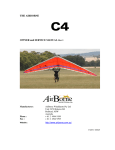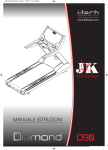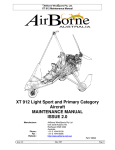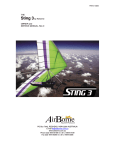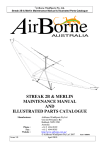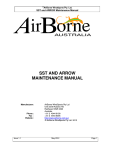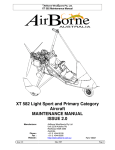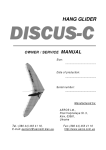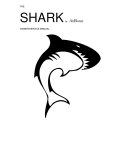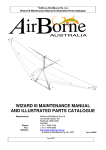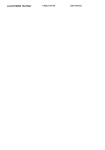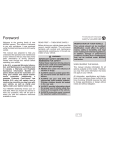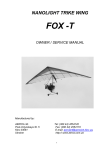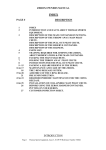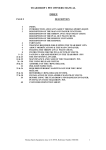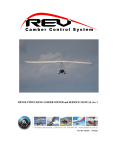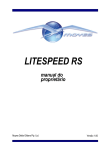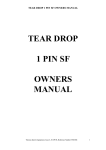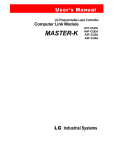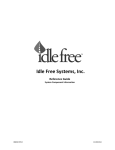Download CLIMAX C2 - Airborne Australia
Transcript
THE CLIMAX C2 OWNER and SERVICE MANUAL Rev 4 PO Box 7042, REDHEAD, NSW 2290 AUSTRALIA E-mail [email protected] www.airborne.com.au Phone (02) 4944 9199 Int +61 2 4944 9199 Fax (02) 4944 9395 Int +61 2 4944 9395 CLIMAX C2 MANUAL REVISION HISTORY Revision No Description 0 Original 1 Inclusion of drawings 2 Tip lever standard positions changed. Inclusion of performance tuning information 3 Climax C2 4 Pull back 2:1 Batten Clips Sprog templet Issue Date: 24/08/04 Rev 4 Applicable Serial No CL13-1 CL14-1 CL13-1 CL14-1 CL13-97 CL14-53 Date 1st February 2001 1st October 2001 1st March 2002 C2-13: 150 C2-14: 100 1st September 2002 C2-13: 163 C2-14: 120 1st February 2003 Page 2 CLIMAX C2 Issue Date: 24/08/04 Rev 4 Page 3 CLIMAX C2 TABLE OF CONTENTS TABLE OF CONTENTS _____________________________________________ 4 Section 1 DESIGN FEATURES _____________________________________ 6 Section 2 SPECIFICATIONS _______________________________________ 7 Section 3 OPERATING LIMITATIONS _______________________________ 8 Section 4 WARRANTY STATEMENTS _______________________________ 9 Section 5 ASSEMBLY PROCEDURES ______________________________ 10 ASSEMBLING ON THE FRAME ________________________________________________ 10 ASSEMBLING LYING FLAT____________________________________________________ 13 Section 6 PRE-FLIGHT INSPECTION_______________________________ 15 HANG GLIDER DAILY INSPECTION ____________________________________________ 16 Section 7 BREAK DOWN PROCEDURE ____________________________ 17 Section 8 SHORT PACKING ______________________________________ 19 ASSEMBLE FROM SHIPPING LENGTH__________________________________________ 19 BREAKDOWN FOR SHIPPING _________________________________________________ 20 Section 10 SAIL REMOVAL AND RE-INSTALLATION __________________ 21 REMOVING THE SAIL ________________________________________________________ 21 RE-INSTALLING THE SAIL ____________________________________________________ 22 Section 11 FLIGHT TECHNIQUE ___________________________________ 23 TAKE OFF ..DON'T FORGET TO HOOK IN... ______________________________________ 23 TURNS ____________________________________________________________________ 23 STALLS____________________________________________________________________ 23 SPINS _____________________________________________________________________ 23 THERMALLING _____________________________________________________________ 24 LANDING __________________________________________________________________ 24 Section 12 TUNING ______________________________________________ 25 PITCH TRIM ________________________________________________________________ 25 PITCH STABILITY SYSTEM ___________________________________________________ 25 CHECKING THE CLIMAX STABILITY SYSTEM ____________________________________ 26 PREPARING THE TEMPLATE _______________________________________________ 26 CHECKING THE SPRONG ANGLES __________________________________________ 26 ROLL/YAW TRIM ____________________________________________________________ 27 ROLL TRIM ADJUSTMENTS ___________________________________________________ 28 TIP LEVER ADJUSTMENT ____________________________________________________ 29 SPROG ADJUSTMENT FOR SYMMETRY ________________________________________ 29 HANDLING AND PERFORMANCE TUNING_______________________________________ 30 Issue Date: 24/08/04 Rev 4 Page 4 CLIMAX C2 Section 13 PERIODIC INSPECTIONS and MAINTENANCE______________ 31 MAINTENANCE SCHEDULE____________________________________________________31 LOG BOOK__________________________________________________________________31 NOTES ON PERIODIC INSPECTIONS____________________________________________32 AIRFRAME TUBING ________________________________________________________32 CARBON CROSS TUBES____________________________________________________32 BOLTS ___________________________________________________________________32 INSPECTION AFTER HARD LANDING _________________________________________33 DEFECT REPORTS ________________________________________________________33 Section 14 TRANSPORTATION AND STORAGE ______________________ 34 Section 15 MAINTENANCE RECORD _______________________________ 35 Section 16 HANG GLIDER COMPLIANCE SCHEDULES________________ 36 GLIDER MODEL: CLIMAX 13 _________________________________________________36 GLIDER MODEL: CLIMAX 14 _________________________________________________37 Section 17 SPROG ANGLE TEMPLATES ____________________________ 38 GLIDER MODEL: CLIMAX 13 _________________________________________________36 GLIDER MODEL: CLIMAX 14 _________________________________________________37 Section 18 ASSEMBLY DRAWINGS ________________________________ 40 CLIMAX II CENTER SECTION ASSEMBLY A4-5241 ________________________________41 CLIMAX VG ASSEMBLY A4-5242_______________________________________________43 CLIMAX X-BAR LEADING EDGE ASSEMBLY A4-4824______________________________45 CLIMAX CAM JUNCTION ASSEMBLY A4-4981____________________________________47 NOSE JUNCTION ASSEMBLY A4-4828__________________________________________49 CLIMAX REAR KEEL ASSEMBLY A4-4829 _______________________________________51 HG A-FRAME FAIRED CORNER UNIT ASSEMBLY TPYE AB A4-7237 _________________53 STREAMLINE CONTROL FFRAME A4-4983 ______________________________________55 MICRO-DRAG CONTROL FRAME A4-5317_______________________________________57 CLIMAX REAR LEADING EDGE ASSEMBLY A4-4825 ______________________________59 DIVE STRUT ASSEMBLY A4-4978 ______________________________________________61 Issue Date: 24/08/04 Rev 4 Page 5 CLIMAX C2 Section 1 DESIGN FEATURES Designed and manufactured by AirBorne Windsports, the Climax is one of the most advanced high performance topless hang glider on the market. The Climax C2 is the result of further refinements to the design. Attention to detail and weight saving has allowed the Climax to have excellent static balance. A larger than average VG range provides the Climax with ease of handling and a large flare window without compromising outstanding glide performance throughout the speed range. The Climax has an elliptical tip, which in the VG full setting allows a very tight mainsail whilst maintaining a progressive washout line right through to the tip. AirBorne’s original cam VG system has been improved allowing an increase in VG travel. Not only does the wing pull exceptionally flat when full on, the VG off setting is quite loose resulting in extremely light handling and improved climb ability. There are several advantages using the cam VG system. The drag in the pulley actuating system and lack of movement in the high load junctions allow for much lower operating pressures. The cam VG system also maintains constant anhedral, which significantly reduces glider oscillation throughout the VG range. A combination of internal cloth ribs and Velcro tabs between the upper and lower battens control the under surface blow down at lower angles of attack. Not only does this minimise glider oscillation the resulting pitch pressure is progressive and predictable. Wire braced washout tubes, or sprogs are used in the Climax. The centre sprog has a compensating system, which causes the sprog to raise approximately 120 mm when the VG is released. Certification pitch testing has confirmed the stability of the system with excellent pitching moment results throughout the VG range. The Climax is easy to assemble or break down. It may be set up on the A-Frame or laid flat, thereby accommodating for personal preference or site characteristics and restrictions. Pip pins and quick clips are used with integrated spring battens to speed up assembly. The sprog tubes are secured by simply closing the zips. Easy operating internal tip levers are used to load the tip rods. At AirBorne we have a well-developed quality assurance program, ensuring that every glider is built in accordance with the standard it was designed and tested to. This gives even the most experienced pilot a sense of security. We hope that you have hours of great flying with your new glider. Fly high and safely. Rick, Russell and Shane Duncan, Rob Hibberd and Paul Mollison AirBorne WindSports Issue Date: 24/08/04 Rev 4 Page 6 CLIMAX C2 Section 2 SPECIFICATIONS SAIL AREA WING SPAN ASPECT RATIO NOSE ANGLE DOUBLE SURFACE % BATTENS GLIDER WEIGHT ASSEMBLY TIME PACK UP LENGTH SHORT PACK LENGTH RECOMMENDED PILOT HOOK IN WEIGHT RANGE (Includes Equipment) VNE (Recommended Maximum Velocity) VA (Recommended Maximum Rough Air Manoeuvring Velocity) VD (Maximum Steady State Velocity) CLIMAX 13 & C2-13 METRIC IMPERIAL 13.1 sq 141 sq ft meter 9.6 m 31.5 feet 7.0 128-133 degrees 92% 22 + 6 33 kg 73 pound 10 min 4.9 meter 16’ (feet) 3.8 meter 12’-6” (feet) 55-90 kg 121-198 pounds CLIMAX 14 & C2-14 METRIC IMPERIAL 14.3 sq 154 sq ft meter 10.4 m 34.0 feet 7.5 128-133 degrees 92% 24 + 6 36 kg 79 pound 10 min 5.3 meter 17’-3” (feet) 4.1 meter 13’-6” (feet) 75-120 kg 165-264 pounds 85 km/h 53 mph 85 km/h 53 mph 74 km/h 46 mph 74 km/h 46 mph 115+ km/h 70+ mph 115+ km/h 70+ mph Note: The stall speed of the Climax at maximum recommended wing loading is less than the minimum requirement of 25 mph (40 km/h). The minimum or steady state speed is at least 35 mph (56 km/h) for a prone pilot with correctly adjusted harness. Conversions: * 0.4536 kg/pound * 25.4 mm/inch * 1.609 km/mile Va = Test speed x 0.707 Vne = Test Speed x 0.816 Issue Date: 24/08/04 Rev 4 Page 7 CLIMAX C2 Section 3 OPERATING LIMITATIONS WARNING Hang Gliding is a high-risk sport. The safe operation of this hang glider ultimately rests with you, the pilot. We believe that in order to fly safely you must maturely practice the sport of hang gliding. You should never fly this hang glider beyond the placard limits. The velocity never to exceed (VNE) for your glider is given in Section 2, as is the maximum speed for manoeuvres or flying in rough air (VA). The indicated airspeeds given are for calibrated instruments mounted on, or near, the base bar of the control frame. It is recommended that you fly your Climax with an airspeed indicator, as it is relatively easy in the VG on configuration to exceed the placard limitations. Flight operations should be limited to non-aerobatic manoeuvres where the pitch angle does not exceed 30 degrees up or down to the horizon and where the bank angle does not exceed 60 degrees. Aggressive stalls and spins should not be attempted. Operations outside the recommended flight envelope, such as aerobatic manoeuvres or erratic pilot technique may ultimately produce equipment failure. Your glider was designed for foot launched soaring and should not be flown by more than one person at a time. It should not be flown backwards or inverted. The setting up and breaking down of a hang glider, transportation on cars and flying itself will have an effect over time on its structural integrity. The glider will require maintenance as outlined in the maintenance section of this manual. Like any aircraft safety depends on a combination of careful maintenance and your ability to fly intelligently and conservatively. The owner and operator must understand that due to inherent risks involved in flying a hang glider, no warranty of any kind is made or implied against accidents, bodily injury and death, other than those that cannot by law be excluded. We hope that your new glider will provide you with many hours of safe flying. AIRBORNE. Issue Date: 24/08/04 Rev 4 Page 8 CLIMAX C2 Section 4 WARRANTY STATEMENTS This warranty extends to new Hang Gliders and/or accessories and equipment manufactured by AIRBORNE WINDSPORTS PTY LTD ("Airborne") and shall not embrace any other accessories or equipment in the sale. AIRBORNE warrants to the customer the hang glider and/or accessories manufactured or supplied by AIRBORNE to be free from defect in material and workmanship under normal use and service and of merchantable quality and fit the purpose for which they are ordinarily used. This Warranty will apply for a period of ninety (90) days from the date of dispatch of the hang glider not withstanding the number of hours flown but subject to the hang glider remaining the property of the customer. This warranty does not exclude any rights implied in favour of any customer by any applicable Federal and State legislation. AIRBORNE will make good any parts required because of defective material or workmanship as set out in the Warranty. THE WARRANTY WILL NOT APPLY TO: Any mechanical adjustments, parts, replacements, repairs or other servicing that in the judgement of AIRBORNE are made or should be made as maintenance. Any defect caused by any alteration or modification not approved by AIRBORNE. Any defect caused by the fitment of parts that are not made or approved by AIRBORNE. Any defect caused by misuse, accidents, negligence or failure to carry out proper maintenance service. Damage caused by continued operation of the hang glider after it is known to be defective. Any defect or consequential loss, damage or injury caused by overloading. Loss of use of the hang glider, loss of time, inconvenience, damages for personal injuries, loss of property or other consequential damages. Failure due to wear and tear, accident, fire, incorrect or incomplete rigging and/or assembly, exposure to the elements, operation outside the placarded limitations and repairs attempted or made other than by AIRBORNE or it'sauthorised agent. AIRBORNE will replace, free of charge, any original part that is determined by it to be defective under the terms of this Warranty and reserves the right to pay monetary compensation or make good the defect in any manner it deems appropriate. The customer is responsible for transporting the hang glider or parts to and from AIRBORNE or its authorised agent when making claims under this Warranty. The hang glider or parts are at the customer's risk whilst in transit to and fromAIRBORNE or its authorised agent. NOTE: Warranty service is available to the customer from AIRBORNE WINDSPORTS PTY LIMITED or authorised agent. Issue Date: 24/08/04 Rev 4 Page 9 CLIMAX C2 Section 5 ASSEMBLY PROCEDURES The wing can be assembled in two positions, either lying flat or standing on the control frame. Assembling the Climax on the control frame is the most popular method of assembly in light winds. This method is preferable as the sail is less prone to being soiled or damaged during assembly. In higher winds it is preferable to lay the glider flat for assembly with the nose into the wind until ready to launch. ASSEMBLING ON THE FRAME UNZIP THE BAG. Lay the wing down with zip up and the nose facing approximately 120 degrees from the wind direction. ASSEMBLE CONTROL FRAME. Spread the control bar down tubes and insert the base bar. The pip pin is then inserted with the cover firmly secured. Check that all the rigging wires are outside the control frame. STAND GLIDER UP. Rotate the control frame to the vertical position and rotate the wing 180 degrees so that it is sitting on the base bar. REMOVE BAG. Remove the glider bag and unclip all of the ties. The Sprog tube covers should also be removed at this time. INSERT NOSE BATTEN. Load the nose battens on the locating pins at this time. If you fail to load the battens prior to tensioning the glider the VG should be pulled full tight before attempting to load the battens. SPREAD LEADING EDGES. Carefully spread both leading edges out half way firstly then spread leading edges to their approximate flying position. Check the side wires are not twisted. IT IS ESSENTIAL THAT THE KEEL AND THE LEADING EDGES ARE KEPT IN THE SAME PLANE OR DAMAGE WILL RESULT. ATTACH FRONT FLYING WIRES. Ensure that the front flying wires are secure and that the quick clip is positively locked. INSERT MAINSAIL BATTENS #1 - 4. Remove the battens from the bag. The red battens are for the left side and the green for the right. Insert the battens from the centre to the tip with gentle pressure, until the batten meets resistance. Shake the sail at the trailing edge whilst maintaining gentle pressure on the batten to allow the batten to be inserted over the cross bar. DO NOT FORCE THE BATTENS! The spring battens should be located securely in the trailing edge fold. Issue Date: 24/08/04 Rev 4 Page 10 CLIMAX C2 TENSION CROSS BARS. The cross bars are now tensioned by pulling the 2:1 pull back rope until the shackle is positioned on the Quick Clip. Ensure that the catch is positively locked. INSERT TIP RODS. Remove the tip bags and insert the tip rod into the tip plug fitting at the rear of the leading edge. Ensure that the rod is fully inserted. LOAD TIP ROD. Move to the front of the wing. For the right tip hold the rear leading edge with your right hand and the end of the sail with your left. Align the lever plug and bend the tip tube towards the trailing edge as you tension the sail. Locate the plug on the end of the tube. When installing the left tip rod the leading edge should be held with your left hand. CLOSE TIP LEVER. Move to the tip. Place you left thumb in the rope loop of the tip lever and close the lever. The lever should be held in the same plane as the trailing edge. Do not let the lever close rapidly as damage may result. Check that the lever is against the fibre tube and is not being forced above or below the tube. Close the zip once the lever is properly closed. THREADED END Issue Date: 24/08/04 Rev 4 PIVOT BEAK INSERT REMAINING MAINSAIL BATTENS. Slide batten into sail pocket. Unclip ‘pivot beak’ from ‘threaded end’. Rotate pivot beak and locate in sail as shown. While supporting the underside of the batten, clip the pivot beak into threaded end. To adjust batten load tension, release pivot beak from sail and rotate batten clip. Ensure battens have an even tension distibution. Page 11 CLIMAX C2 LOAD SPROGS. The sprogs should be rotated into position over the red webbing loops and the zips closed fully. It is a good time to inspect the junctions prior to closing all zips. INSERT UNDER SURFACE BATTENS. The under surface battens should be inserted as far as possible. The batten should then be pushed in with your thumb. Use the string to pull the batten to the rear of the pocket. INSTALL NOSE FAIRING. Attach the nose fairing applying the top velcro first then gently tension over the nose plates and attach the velcro to the under surface. PRE-FLIGHT INSPECTION. You are now ready for the wing pre-flight inspection as outlined in the next section. It is imperative that you carry out this inspection every time you rig and before you fly. Issue Date: 24/08/04 Rev 4 Page 12 CLIMAX C2 ASSEMBLING LYING FLAT UNZIP THE BAG. Lay the wing down with zip up and the nose facing into the wind. Unzip the bag and unclip centre ties ASSEMBLE CONTROL FRAME. Spread the control bar down tubes and insert the base bar. The pip pin is then inserted with the cover firmly secured. Check that all the rigging wires are outside the control frame. ROTATE GLIDER. Rotate the glider so that the control frame is under the wing. Make sure the rigging is not tangled. REMOVE BAG. Remove the glider bag and unclip all of the ties. The Sprog tube covers should also be removed at this time. INSERT NOSE BATTEN. Load the nose battens on to the locating pins at this time. Failure to do so will make it difficult to locate the battens after the sail is tensioned. SPREAD LEADING EDGES. Carefully spread both leading edges out half way firstly then spread leading edges to their approximate flying position. Check the side wires are not twisted. IT IS ESSENTIAL THAT THE KEEL AND THE LEADING EDGES ARE KEPT IN THE SAME PLANE OR DAMAGE WILL RESULT. INSERT TIP RODS. Remove the tip bags and insert the tip rod into the fitting at the rear of the leading edge. Ensure that the rod is inserted all of the way. LOAD TIP ROD. Move to the front of the wing. For the left tip hold the rear leading edge with your left hand and the end of the sail with your right. Bend the tip tube towards the trailing edge as you tension the sail. Locate the tip lever on to the tip rod. When installing the right tip rod the leading edge should be held with your right hand. CLOSE TIP LEVER. Move to the trailing edge. Place you right thumb in the rope loop of the tip lever and close the lever. The lever should be held in the same plane as the trailing edge. Do not let the lever close rapidly as damage may result. INSERT MAINSAIL BATTENS. Remove the battens from the bag. The red battens are for the left side and the green for the right. Insert the battens from the centre to the tip with gentle pressure, until the batten meets resistance. Shake the sail at the trailing edge whilst maintaining gentle pressure on the batten to allow the batten to be inserted over the cross bar. DO NOT FORCE THE BATTENS! The spring battens should be located securely in the trailing edge fold. The tip batten should have the bungie doubled for additional tension. Issue Date: 24/08/04 Rev 4 Page 13 CLIMAX C2 TENSION CROSS BARS. The cross bars are now tensioned by pulling the webbing loop until the shackle is positioned on the Quick Clip. Ensure that the catch is positively locked. When tensioning with the glider lying flat the keel can be raised approximately 200 mm to allow the side flying wires to be loose. ATTACH FRONT FLYING WIRES. Lift glider and attach front flying wires. Ensure that the front flying wires are secure and that the quick clip is positively locked. INSTALL NOSE FAIRING. Attach the nose fairing applying the top velcro first then gently tension over the nose plates and attach the velcro to the under surface. LOAD SPROGS. The sprogs should be rotated into position over the red webbing loops and the zips closed fully. It is a good time to inspect the junctions prior to closing all zips. INSERT UNDER SURFACE BATTENS. The under surface battens are inserted then pulled back into the rear of the batten pocket with the string handle. PRE-FLIGHT INSPECTION. You are now ready for the wing pre-flight inspection as outlined in the next section. It is imperative that you carry out this inspection every time you rig and before you fly. Issue Date: 24/08/04 Rev 4 Page 14 CLIMAX C2 Section 6 PRE-FLIGHT INSPECTION The wing was designed so that drag would be kept to a minimum. This means that most of the pre flight check points are enclosed. A thorough pre-flight inspection is mandatory for any aircraft, and the best technique is a circular walk around the wing. The nose area is the ideal place to start your pre-flight check, followed by each assembly point. Keep in mind the three most critical set up areas: THE NOSE QUICK CLIP CONTROL BAR BASE TUBE FASTENERS THE CROSS BAR TENSIONER QUICK CLIP. Starting at the nose we suggest the following checklist (ensuring all bolts and fasteners have the appropriate thread protruding beyond the nut). Check the nose plate assembly ensuring that the VG routing is normal. Sight along both leading edges checking for similar curves. Walk towards the tip feeling for dents in the leading edge. Check cross bar/leading edge junction through the zipper access. Check sail tip lever is fully closed and the sail is not damaged. Check the tip rod is properly located and the rear leading edge is undamaged. Walk towards the keel checking all battens are secured. Check the sprogs are in order and the zips are fully closed Check the cross bar retaining shackle is secured on the quick clip. Repeat the above steps for the other side wing in reverse order. Check all lower rigging is correctly routed and free from damage. The most likely area for damage on wires is around the swage and thimble area. Check Control Bar corners are correctly assembled with pip pin and cover. Ensure the hang loop rocker is rotated 90 degrees to the keel and that hang loops are securely positioned and in good order. The hang loop should be free to move in both directions. Issue Date: 24/08/04 Rev 4 Page 15 CLIMAX C2 Check control bar top assembly and ensure that the down tubes are straight. Unzip under surface and check cross bar hinge and restraining straps. The VG should be operated and inspected to ensure it is functioning properly. Ensure that the double surface is zipped up and nose fairing is secure. Clip your harness into the main and back up hang loops and perform a "hang check". Make sure that your harness is the correct distance from the base bar, your leg loops are secure and your carabina is locked. HANG GLIDER DAILY INSPECTION Inspection of the following items after every assembly of the glider is required: Check for bends, dents, scratches in all tubes. Check wire ends for bolt and/or other fastener security. Check wires for twisted or jammed thimbles. Check wires are free of kinks, frays, abrasions, broken strands etc. Nose plate connections; spring clip retains front wires. Tips secure; tip rod and lever undamaged, zipper closed. Battens and bungies; springs functioning smoothly and no frays on bungies. A frame connection on both sides; spring pins located correctly. Variable geometry operation (full and free movement). Rear keel connections; spring clip retains shackle and tensioner cable. Crossbar tension wire; free of kinks, frays, abrasions, broken strands. Crossbar operation (free floating). Sprog tubes and rod ends and clevis pins secure. Sail condition; no tears, symmetrical appearance. Harness straps and webbing secure, height adjustment correct. Emergency parachute secure, correctly mounted and attached, operating handle accessible. Issue Date: 24/08/04 Rev 4 Page 16 CLIMAX C2 Section 7 BREAK DOWN PROCEDURE To break down your Climax, just reverse the set-up procedure steps as described. Included here are a few guidelines to follow which will save you time and prevent potential wear areas on your sail. It is possible to leave the nose battens in during daily operations! Remove nose fairing. Unzip sprogs and rotate them towards each other. The sprogs remain outside the sail. Remove four or five tip battens and the under surface battens. Unload tip lever and remove tip rod. Fold tip lever towards sail and roll sail whilst keeping tension along the trailing edge. Fit tip bags. Let off the sail tension and pull each wing in slightly. Pull out the remaining battens. Attach top control bar padding. Fold both wings in symmetrically, bringing both leading edges back at the same time or in small steps side to side. Place padding over the keel end and rear quick clip. Place sprog covers over sprogs. Roll the sail up parallel to the leading edge. One tie should be wrapped around the keel and leading edge to hold them together whilst the other side wing is rolled. Ensure that the sail is rolled into the leading edge pockets. It is important that the ties are not over tensioned as this can damage the mylar insert. Position glider bag. Roll glider over and undo control bar pip pin. Fold base bar rearward. Attach base bar padding around down tube base. Place padding over the speed bar. Undo the two centre ties and fold the control bar down between the leading edge pockets. Lay the wires smoothly to avoid kinking. Secure the centre ties and zip up bag. Issue Date: 24/08/04 Rev 4 Page 17 CLIMAX C2 The Climax has 1x19 wires to minimize drag. The wires are more prone to kinking and should be treated with care. For de-rigging flat, attach top control bar padding. Undo nose wires and pull wing forwards then follow steps as above. If resistance is encountered during any phase of set up or break down procedure stop and investigate. Issue Date: 24/08/04 Rev 4 Page 18 CLIMAX C2 Section 8 SHORT PACKING ASSEMBLE FROM SHIPPING LENGTH If your Glider was delivered to you in the short pack form the following procedure should be used. Unzip bag and remove ties. Remove all padding from the tube ends. Assemble the control frame as described in the set up procedure section. Rotate the glider on to the control bar, lying flat on the ground. Spread both leading edges approximately ½ metre. Remove the tip bags, which have been used as protection on the rear of the front leading edges. Check rear leading edges for R (right) and L (left). Insert rear leading edges in the appropriate side of the front leading edge. Align and push on the leading edge then rotate slightly to ensure it is located correctly. It should be impossible to rotate leading edge if correctly installed. Ensure outer sprong exits through the zipper as shown (right). the the Attach inner sprog to sprog cone with the clevis pin and locking ring as shown. For details see page 45. You are now ready to tension the sail. There is a webbing strap attached inside the sail with small tang. Tension this tang using a small rope as a handle and attach to the rear leading edges with the self tapping screw. The tang fits into a slot milled into the end of the plastic bung, which locates the tip rod cup. Repeat for the other leading edge. Issue Date: 24/08/04 Rev 4 Page 19 CLIMAX C2 If you find the above technique to tension the sail difficult the following method can be used: Remove the nose webbing tangs from their bolts at the nose plate. Locate the tip webbing tangs with the screws as described previously. Slowly spread the leading edges out. Ensure the sail is able to move forward as the leading edges are spread and is not caught on the nose pulley or damage will result. Fit both nose battens onto the locating pins. The cross bars can now be tensioned. Check once again the sail is OK at the nose. Locate nose-webbing tangs to original positions then let cross bar tension off. Your glider can now be fully assembled as outlined in the Set Up Procedure BREAKDOWN FOR SHIPPING Reverse the procedure above ensuring that all possible wear points are padded. Be careful when folding the sail as the mylar leading edge insert may be damaged. When you have finished packing the glider, place the front of the glider bag over the rear of the short packed glider. Zip up bag carefully and place the rest of the bag inside the package. (The bag is installed back to front because it is tapered and the glider is more bulky at the rear when short packed.) Issue Date: 24/08/04 Rev 4 Page 20 CLIMAX C2 Section 10 SAIL REMOVAL AND RE-INSTALLATION Many of the maintenance requirements outlined in this manual will require the removal of the sail from the airframe. When outlining the procedure to remove the sail we assume that you have had some experience in removing a sail from a glider. If you have not we suggest that you have some one help you that does have experience or have an authorised Airborne dealer remove and re-install the sail for you. It is important to re-install hardware as you disassemble so that components are not misplaced. REMOVING THE SAIL You will need a clear area of approximately 2 meters by 10 meters. A rough surface such as concrete should have a tarp laid down prior to working on the glider. Lay the glider on the ground and unzip the bag and remove all ties. Remove the base bar from the control frame. Remove the Phillips screw, which secure the webbing on the rear leading edge. Remove the sail tangs from the nose plate bolts. Undo the front under surface zip completely. Remove hang loop. Undo front VG pulley bungie from sail. Remove the rear wires and keel pocket tang from the rear quick clip. Remove the side wires from the cross tube and pull the wires outside of the sail. With the leading edges spread approximately ½ meter gently slide the frame forward out of the sail. Be careful that the frame hardware, particularly the cam plates and sprogs do not catch on the internal cells or velcros. Do not force the removal of the frame otherwise damage will result. If the sail is to be sent to the factory for repair the transverse battens should be removed. The mylar can be left in but care should be taken not to damage the mylar when folding the sail. Issue Date: 24/08/04 Rev 4 Page 21 CLIMAX C2 RE-INSTALLING THE SAIL Install the transverse battens. Fold the sail so that the mylar pockets are together. The under surface should be on the outside. Lay the sail flat and open up the nose area slightly. Prepare the frame by taping the sprogs so that they are folded towards each other. If possible it is best to have a cover over each leading edge as this will reduce the chances of the frame snagging on the cells or velcros. Position the frame with the leading edges together and in the correct orientation (ie cross tubes to the top of the sail). Slowly slide the frame into the sail through the main centre zip ensuring that the tubes are forward of all velcros and cells. Make sure that the keel passes through the keel pocket. You will need to periodically check that the sail is clearing all internal cells and velcros. Be careful and slide the frame in slowly otherwise damage will result. As the frame is around half way in route the inner sprog tubes through the sprog zips. When the frame is in all the way the sail can be pulled on further at the tip to allow the rear sprogs to exit the respective zip. After the frame is fully installed attach the rear webbing to the rear leading edge bung. When tightening the screw ensure that the tang is located in the slot. Using a piece of string on the nose webbing tension the leading edge pocket so that the tang is installed on the nose plate bolt. Attach the front pulley bungie to the sail. Re-connect the bottom surface zip checking that the two sides are aligned. Re-tie the bungie between the eyelets so that it secures the excess zip. Route the side wires through the sail and install them on the cross bar bolts with the side wire positioned between the VG actuating cable and the leading edge. Do not over tighten as the carbon tube can be damaged. Attach the keel pocket tang and the rear wires to the quick clip bolt. Ensure that the quick clip is oriented correctly before tightening. Make sure that the flat spring is located properly. Attach the base tube and rotate the glider on to the control frame. Spread the wings slowly checking that nothing has fouled and that the velcros and cells are the rear side of the cross tubes. Attach the back up hang loop around the keel and install the main loop to the rocker. Make sure that each side of the main loop passes through the slots in the under surface. Assemble the glider completely as described earlier in the manual. Perform a complete and thorough pre flight of the glider in accordance with the procedures outlined earlier in the manual. Issue Date: 24/08/04 Rev 4 Page 22 CLIMAX C2 Section 11 FLIGHT TECHNIQUE TAKE OFF ..DON'T FORGET TO HOOK IN... The VG should be in the full off position for launching. The Climax has a slightly tail heavy static balance and is very easy to launch. Hold the nose in a slightly elevated position, approximately 20 degrees to the slope with the wings level, run hard keeping the nose at the same angle. It is important that the pilot accelerates smoothly during the launch run. Taking increasingly larger steps until lift off is the preferred method. Too fast an acceleration will cause the nose to rise rapidly with the risk of stall on launch. TURNS The Climax can be easily directed into a turn even at slow speeds, however for a fast roll rate and easier handling, it is best to pull on a little extra flying speed. The Climax will maintain a turn until the turn is removed by pilot input. Allow yourself plenty of margin for safety. Don't fly too slowly when flying close to the hill or other aircraft. STALLS When practising stalls make sure you have sufficient altitude. Push out slowly (approx 1 mph per sec. speed reduction), the glider will tend to mush without dropping a wing. The sink rate will increase in this mush mode more than two fold. If you push out faster the nose will pitch higher, a gentle pitch down follows until the glider regains flying speed and recovers from the stall. A stall at full VG will result in a much more rapid pitch down and should be avoided. Never stall the glider with the nose pitched up too high. This is a dangerous manoeuvre and can result in a tail slide and severe tumble. As a guideline, the angle at which the glider stalls results in a similar negative angle to recover. If you push out too much in a turn the glider will turn tighter unless you are flying very slowly, in which case you may tip stall. So keep on a little extra speed in turns until you get used to the glider. SPINS As with all recent gliders the Climax will resist spinning. If you do stall a wing in a turn and enter the initial stages of a spin, move your weight forward and to the high side of the rotation and the glider will recover. Issue Date: 24/08/04 Rev 4 Page 23 CLIMAX C2 THERMALLING The optimum speed for thermalling is a little above stall speed; it may be necessary to fly faster than this in rough conditions to maintain good control. Depending on the nature and area of the thermal a bank angle of between 10 and 50 degrees can be used. LANDING Landing is easy in the Climax. Your final approach should be a straight glide into the wind faster than trim speed. You should feel positive (nose up) bar pressure. The VG should be in the off position. Reduce air speed slowly by relaxing the bar pressure smoothly. Keep wings level whilst looking straight up your runway. When the glider reaches trim speed a full flare is required. Flare aggressively in light or no wind, holding the uprights out and up. It is important that the pilot does not swing the legs forward whilst flaring. This results in the pilot's centre of gravity moving forward which will cause the nose to drop. Upon touchdown the pilots legs must provide a gentle deceleration, coasting to a stop. (No aircraft lands well with the brakes locked on!) In strong wind it is possible to fly the glider onto the ground slowing up gradually. Be careful not to push out too hard in windy conditions. Issue Date: 24/08/04 Rev 4 Page 24 CLIMAX C2 Section 12 TUNING Your Climax was test flown and delivered to you in good trim by either your dealer or by factory pilots. If, however, any adjustments are made to your glider, we recommend that they be recorded in your maintenance log at the rear of this manual. If you feel that the glider requires adjustment to trim in the roll or pitch axis you should check that the problem is not caused by something asymmetrical in the frame or battens. In order of priority, check the following: Ensure that the wires are correctly routed. Check the battens against the profile. Check that the batten bungies have the same tension on both sides. Spring battens should be checked for normal operation. Check that the keel is straight. Check that the sail is correctly mounted on the leading edges. Checks that both sprog assemblies are not damaged. Check leading edges are straight and the rear leading edges are located correctly. PITCH TRIM To make the glider trim faster move the main hang strap forward and to trim slower move the hang loop rearward. The hang loop should be adjusted one hole at a time. A heavier pilot may make the glider trim slower than a lighter pilot. The heavier pilot causes an increase in twist through extra leading edge flex. Minor changes in hang loop position should be used to fine-tune the glider for the particular pilot. PITCH STABILITY SYSTEM Stability in the pitch axis is provided by maintaining twist outboard of the cross bar leading edge junction. Internal washout struts (sprogs) are used to maintain a minimum amount of twist to maintain the required level of pitch stability. Correct attachment and adjustment of the sprogs is essential for maximum stability. Do not lower your sprogs below the factory standard settings. Lowering your sprogs will result in reduced pitch stability Alterations to the lengths of rigging, airframe or adjustments to the airfoil can also have adverse effects on pitch stability. Issue Date: 24/08/04 Rev 4 Page 25 CLIMAX C2 CHECKING THE CLIMAX STABILITY SYSTEM The Climax has a compensated internal sprog. As the VG pulls the sail flatter the Inboard sprog automatically lowers with the trailing edge. To confirm that the sprogs are correctly set the VG must be in a definitive position. The method used checks the sprog angle relative to the root angle of the glider. This method is simpler to use than a string line on the trailing edge and is very accurate if the correct procedure is used. PREPARING THE TEMPLATE A template is supplied in the rear of the manual, which is used to check the sprog settings. Cut accurately along the top doted line. It is important that the cut is accurate as this edge is lined up with the sprogs and determines the relative angle to the keel. Cut a piece of cardboard to the same size as the paper and glue the template to the cardboard. Thick cardboard of around 3-5mm is best. Once again it is important to accurately cut the top edge. Glue the paper template to the cardboard with the top edges accurately aligned. Punch a small hole at the top left hand corner of the template where marked. A piece of 2mm string around 1 meter long with a small weight is used as the "plum bob". The string is passed through the hole with a knot on the rear side of the template to secure the line. CHECKING THE SPRONG ANGLES Fully assemble the glider on a flat even surface. Set the VG as shown on the diagram on the set up template. The inner sprog compensation requires this setting to be accurate. Use a stand or step ladder to achieve a zero keel angle (horizontal). The glider should be supported as close as possible to the rear wires so that the rear keel tube is not bending under the gliders own weight. Issue Date: 24/08/04 Rev 4 Page 26 CLIMAX C2 Align the top of the template to the front of the 42 mm keel tube just behind the step down section. The string line should line up with the vertical line once the keel is perfectly horizontal. Secure the keel so that the glider will not rotate around the control frame once the zero angle is achieved. Re-check the angle. The sprog tubes can move span wise within the red webbings, which will cause discrepancies in the angle readings. The sprog tubes should be pushed to the tip side of the webbing prior to checking as this produces the lowest angle. Place the template under the sprog tube. Push up enough so that the side flying wire goes tight and check the string is aligned with the appropriate line on the template. To adjust the angle fold the sprog out and remove the clevis pin at the front of the tube. Rotate the threaded cone anti clockwise to raise the rear of the sprog. Rotate the threaded cone clockwise to lower the rear of the sprog. ROLL/YAW TRIM Turns in your gliders occur when the glider is asymmetrical. If you have a turn in your glider you should confirm that the 7 possible variables outlined at the beginning of this section have been checked. The glider may have a turn due to several factors. If the turn only appears at VG settings from ½ on to full on it is generally an indication that the sprogs are not set symmetrically. The following tables outline procedures for adjustments. Adjustments should be made to the glider in the sequence as shown. The glider should be tuned firstly in the VG off setting and then checked VG on. If necessary the sprogs must be tuned as outlined in the second table. NOTE: We refer to the fast wing as the wing on the high side of the turn ie. The right wing is the fast wing if the wing is turning left and vice versa. Issue Date: 24/08/04 Rev 4 Page 27 CLIMAX C2 ROLL TRIM ADJUSTMENTS MORE SIGNIFICANT TURN MILD TURN ADJUSTMENTS WHEN THE GLIDER IS CONFIGURED VG OFF TO 1/2 ON ADJUSTMENT METHOD Remedy left turn Remedy right turn DIFFERENTIAL LEADING EDGE TENSION Attach the sail to the Attach the sail to the The tip levers have small inserts as shown on the drawing left tip lever to right tip lever to (Fig 1). To remedy a mild turn the sail tip screw should be increase the sail increase the sail removed and the insert on both sides rotated 180 deg as tension. Attach the tension. Attach the shown in figure 1, page 29. The tip levers should be sail to the right tip sail to the left tip reattached to the sail to adjust a turn as outlined. Specific lever to decrease the lever to decrease settings are referred to in the table following the tip lever sail tension. the sail tension. adjustment drawing. Adjust 3-4mm per side initially. TIP PLUG ADJUSTMENT (TIP UP). Rotate the right tip Rotate the left tip If further adjustment is required the tip angle on the fast fitting anti clockwise fitting clockwise if wing is raised. The tip plug can be rotated to raise or lower if viewed from the viewed from the rear the tip angle on either wing. To raise the tip angle on the fast rear of the leading of the leading edge wing access the fibreglass tip bung through the zip at the edge one hole at a one hole at a time. end of the leading edge tube. Remove the Philips screw and time. adjust as outlined. The standard setting is 2 holes from the zero hole for the C2-13 and 1 hole for the C2-14. The fitting should not be adjusted more than two holes from the standard position per adjustment. Reinstall the screw once adjustment is made. TIP PLUG ADJUSTMENT (TIP DOWN) Rotate the left tip Rotate the right tip If the turn persists the tip angle can be lowered on the slow fitting anti clockwise fitting clockwise if wing. Access the fibreglass tip bung through the zip at the if viewed from the viewed from the rear end of the leading edge tube. Remove the Philips screw and rear of the leading of the leading edge adjust as outlined. edge one hole at a one hole at a time. The standard setting is as above. The fitting should not be time. adjusted more than two holes from the standard position per adjustment. Reinstall the screw once adjustment is made. REAR SECTION ADJUSTMENT. Use the "Y" tool to Use the "Y" tool to If the turn still persists after the tip plug rings have been rotate the right step rotate the left step rotated the front leading edge step down rear eccentric ring down ring antidown ring clockwise can be adjusted. The angle that the rear section protrudes clockwise if viewed if viewed from the from the front section can be altered by rotation of the outer from the rear of the rear of the leading eccentric (plastic) ring. The location of this ring is fixed with leading edge one hole. edge one hole. This a small screw. Remove screw and reinstall once adjustment This raises the RHS raises the LHS rear is made. rear leading edge leading edge If the glider tends to turn the opposite direction after the rear section adjustment the tip plugs should be adjusted to straighten the glider. TIP PLUG ADJUSTMENT LOCATING PIN REAR SECTION ADJUSTMENT REFERENCE LINE RHS rear leading edge shown Issue Date: 24/08/04 Rev 4 RHS leading edge step-down shown Page 28 CLIMAX C2 TIP LEVER ADJUSTMENT FIGURE 1 POSITION B POSITION A REFERENCE POINTS POSITION D POSITION C INSERT ROTATED TO ACHIEVE ADDITIONAL ADJUSTMENT The following table shows standard sail position and variations to the standard setting. Note that there are two "standard" positions. Check the glider serial number prior to making any adjustments. APPLICABLE GLIDER STANDARD POSITION CL13-97 and after CL14-53 and after Position D Prior to CL13-97 Prior to CL14-53 Position A ADJUSTMENTS Position A -4mm Position B +3mm Position C -7mm Position B +7mm Position C -3mm Position D +4mm SPROG ADJUSTMENT FOR SYMMETRY MILD TURN ADJUSTMENTS WHEN THE GLIDER IS CONFIGURED 1/2 ON TO FULL ON ADJUSTMENT METHOD Remedy for left turn OUTBOARD SPROG ADJUSTMENT. The glider should be assembled with the VG off. Unzip the outer sprog and fold forward. Remove the ring and clevis pin from the front of the sprog tube. Make appropriate adjustment and install clevis pin and ring. Install sprog. OUTBOARD SPROG ADJUSTMENT. If the glider still turns the opposite sprog can be lowered as described. Raise the right sprog by rotating the cone anticlockwise by 1/2 turn. Lower the left sprog by rotating the cone clockwise by 1/2 turn. Remedy for right turn Raise the left sprog by rotating the cone anticlockwise by 1/2 turn. Raise the left sprog by rotating the cone anticlockwise by 1/2 turn. If after following the procedure as outlined above the glider still tends to roll one way please contact your AirBorne dealer or call the AirBorne factory. Issue Date: 24/08/04 Rev 4 Page 29 CLIMAX C2 HANDLING AND PERFORMANCE TUNING The following table is designed to allow a pilot to reference methods of tuning the Climax to suit the individual. Varying wing loading will affect the way the glider behaves in pitch and roll trim. For example, a heavier loaded glider will tend to increase the flex in the leading edge tube causing more washout. This increase in washout will tend to make the glider more spirally stable. A lightly loaded glider will tend to be less spirally stable requiring more high siding from the pilot. Adjustments are described assuming that the glider is straight and all adjustments are symmetrical. TUNING CENTER OF GRAVITY TIP PLUGS Rotating the tip plug ref. line down results in an increase in glass tip angle ie Left tip ring clockwise & Right tip ring anticlockwise. INNER RING Rotating the inner rings down results in an increase in the leading edge dihedral ie Left leading edge inner ring clockwise & Right leading edge inner ring anti clockwise LEADING EDGE TENSION Refer to Fig 1 to vary leading edge tension settings HANDLING Increase in pitch pressure when CG moved rearward. Decrease in pitch pressure when moved forward. Rotating the tip plugs down reduces high siding on a bank Rotating the tip plugs up increases the amount of high siding required Rotating the inner ring down reduces high siding on a bank PERFORMANCE No change Slightly reduced performance Slightly better performance Reduction in bar pressure Does not effect performance No Change with small adjustments Rotating the inner ring up increases the amount of high siding required Does not effect performance No Change with small adjustments Increase in leading edge tension slows roll rate A slight increase may improve performance but over tensioning will cause the tip to bend up effectively reducing performance Loss of performance if tension is reduced to the point where the leading edge starts to deform No Change with small adjustments Decrease in leading edge tension improves roll rate Issue Date: 24/08/04 Rev 4 No change BAR PRESSURE Increase in pitch pressure when CG moved rearward. Decrease in pitch pressure when moved forward. Increase in bar pressure No Change with small adjustments Page 30 CLIMAX C2 Section 13 PERIODIC INSPECTIONS and MAINTENANCE MAINTENANCE SCHEDULE 1 – Clean and service, 2 – Check as directed, 3 – Check for security, cracks, wear and faulty operation, 4 Remove, inspect and replace if necessary, 5 Recommend replacement or overhaul. MAINTENANCE REQUIREMENT Maintenance Period Period > Daily Monthly Three Six Every Every 2 Every 4 Months Monthly Year Years Years Flying 1 10 30 50 100 200 400 Days > Wing Fabric deterioration and tears 2 2 2 2 4 5 Wing Fabric Stitching 2 2 2 2 2 Wing Fabric attachment points 3 3 3 3 3 3 Batten Spring Fittings & Elastics 3 3 3 3 4 4 Check Battens against template supplied 2 2 2 2 2 Wing wires and attachment fittings, including sprog wires 2 3 3 4 5 5 5 Check leading edges, keel & A Frame for straightness, 2 2 2 2 4 4 4 dents and corrosion Check leading edges, keel & A Frame structural members 2 2 2 2 4 4 4 and check for fatigue cracks radiating from drilled holes. Check centre junction and carbon spars (See notes) 2 2 2 2 4 4 4 Check cross tube leading edge junction 2 2 2 2 3 3 3 (Remove hinge bolt and inspect bushes, bolt and hole) 4 5 5 5 Check sprog assemblies including rod ends, clevis pins etc 2 2 2 2 2 2 2 Check Inspection Zips 2 2 2 2 2 2 Check Variable Geometry, pulleys and cleats 2 3 3 3 4 4 5 All bolts, nuts, washers & safety pins. At least one thread 2 2 2 2 2 2 2 showing outside each nut. Check hang straps and karabiners for wear or damage 2 2 2 2 4 5 5 Check Saddles and fittings for cracks 2 2 2 4 4 5 It is recommended that: Items marked 1,2 and 3 should be performed by the owner of the glider; Items marked 4 be performed by the owner in conjunction with another pilot; and Items marked with a 5 be performed by Airborne or an accredited Airborne service agent. LOG BOOK When maintenance is performed always check appropriate square and make an entry in the maintenance log at the rear of this manual. Issue Date: 24/08/04 Rev 4 Page 31 CLIMAX C2 NOTES ON PERIODIC INSPECTIONS AIRFRAME TUBING Installation & Removal When removing tubing do not bend or force tubes. If resistance is encountered stop and check for the cause. Do not force the tube. Inspection Inspect tubing for cracks, damage from abrasion, elongated holes or distortion in tube surface. Never attempt to repair tubing, always replace with new part. Inspect tubing for corrosion in and out. If corrosion is present the component should be replaced. Replacement Aluminium tube comes in many different sizes and grades. It is important that the correct replacement parts are used. CARBON CROSS TUBES Installation & Removal To comprehensively check the carbon spars and junction the sail should be removed from the airframe as outlined in this manual. Inspection The carbon cross tubes should be thoroughly inspected for cracks. The aluminium plug, which is bonded into the carbon tube at the centre section, should also be thoroughly checked for damage or cracking at the bond line. A torch should be used to check that the tubes show no signs of damage on the inside. BOLTS Installation & Removal After tightening, all bolts should have at least one and a half to two threads showing. All self-locking nuts should not be installed more than two times. Be sure not to over torque bolts when installing. Inspection Check bolts for worn shanks, bad threads or corrosion. Issue Date: 24/08/04 Rev 4 Page 32 CLIMAX C2 SAILS Sail Inspection Check for tears in the sailcloth or any loose or unravelled seams. Check all inspection zippers to see if they function smoothly and close completely. Inspect tip webbing for damage. Sail may be repaired with appropriate sail tape or a sewn on patch. Airborne or an authorised agent should be consulted about sail repairs. Keep the sail clean of oil and dirt by washing the sail with soap and water. Keep the sail covered when not in use. CONTINUED EXPOSURE TO SUN DRAMATICALLY SHORTENS THE LIFE OF SAILS - possibly to as little as six months. INSPECTION AFTER HARD LANDING It is necessary to do a detailed inspection following any unusual stressing of the Hang Glider this full inspection should include all details listed for the six monthly maintenance. The inspection should be noted in the logbook, and any replacement to be recorded. DEFECT REPORTS Details of any defect which develops in service and which, if kept uncorrected, would compromise the continued safe operation of the hang glider should be reported to Airborne as soon as practicable. Issue Date: 24/08/04 Rev 4 Page 33 CLIMAX C2 Section 14 TRANSPORTATION AND STORAGE Avoid damage to your glider by using well padded racks. Careless transportation can cause considerable damage to your glider. We recommend that you support the glider in at least 3 places to spread the load. The glider should be transported with the control frame down to minimise the chance of damage to the cross tubes. Flat straps should be used for tie downs to avoid damage to leading edge mylar. Store the glider in a dry room off the ground. Air the glider out regularly to avoid mildew, and never store wet. SAFE FLYING TEAM AIRBORNE Issue Date: 24/08/04 Rev 4 Page 34 CLIMAX C2 Section 15 Date Issue Date: 24/08/04 Rev 4 MAINTENANCE RECORD Details of Repair or Maintenance Carried out by: Page 35 CLIMAX C2 Section 16 HANG GLIDER COMPLIANCE SCHEDULES GLIDER MODEL: CLIMAX 13 MANUFACTURED BY: AIRBORNE WINDSPORTS Pty Ltd NOTE: These specifications are intended only as a guideline for determining whether a given glider is a certified model and whether it is in the certified configuration. Be aware, however, that no set of specifications, however detailed, can guarantee the ability to determine whether a glider is the same model, or is in the same configuration as was certified, or has those performance, stability, and structural characteristics required by the certification standards. An owner's manual is required to be delivered with each HGMA certified glider, and it is required that it contain additional airworthiness information. Weight of glider with all essential parts and without cover bags and non essential parts. Leading Edge Dimensions Nose Plate anchor hole to crossbar attachment hole Nose Plate anchor hole to rear sail attachment point Outside diameter at nose Outside diameter at cross bar Outside diameter at rear sail attachment point Crossbar Dimensions Overall pin to pin length from leading edge attachment point to hinge bolt at glider centre line Largest outside diameter Keel dimensions The cross bar centre load bearing pin The pilot hang loop Fwd Rear Sail Dimensions Chord length at 3 ft outboard of centre line Chord length at 3 ft inboard of tip Span (extreme tip to tip) Location of Information Placard Location of Test Fly Sticker Recommended Pilot Hook in Weight Range Recommended Pilot Proficiency Metric 33 kg Imperial 73 lbs 3080 mm 5490 mm 60 mm 62 mm 12 mm 121.26” 216.14” 2.36” 2.44” 1.77” 2871 mm 113.03” 75 mm 2.95” 760 mm 1275 mm 1305 mm 29.92” 50.20” 51.38” 1620 mm 1020 mm 9600 mm 63.78” 40.18” 377.95 “ Front Keel Front Keel 55-90 kg 121-198 lbs Advanced NB: Conversions * 0.4536 kg/pound * 25.4 mm/inch * 1.609km / mile Issue Date: 24/08/04 Rev 4 Page 36 CLIMAX C2 GLIDER MODEL: CLIMAX 14 MANUFACTURED BY: AIRBORNE WINDSPORTS Pty Ltd NOTE: These specifications are intended only as a guideline for determining whether a given glider is a certified model and whether it is in the certified configuration. Be aware, however, that no set of specifications, however detailed, can guarantee the ability to determine whether a glider is the same model, or is in the same configuration as was certified, or has those performance, stability, and structural characteristics required by the certification standards. An owner's manual is required to be delivered with each HGMA certified glider, and it is required that it contain additional airworthiness information. Weight of glider with all essential parts and without cover bags and non essential parts. Leading Edge Dimensions Nose Plate anchor hole to crossbar attachment hole Nose Plate anchor hole to rear sail attachment point Outside diameter at nose Outside diameter at cross bar Outside diameter at rear sail attachment point Crossbar Dimensions Overall pin to pin length from leading edge attachment point to hinge bolt at glider centre line Largest outside diameter Keel dimensions The cross bar centre load bearing pin The pilot hang loop Fwd Rear Sail Dimensions Chord length at 3 ft outboard of centre line Chord length at 3 ft inboard of tip Span (extreme tip to tip) Location of Information Placard Location of Test Fly Sticker Recommended Pilot Hook in Weight Range Recommended Pilot Proficiency Metric 36 kg Imperial 79. lbs 3375 mm 5955 mm 60 mm 62 mm 12 mm 132.87” 234.45” 2.36” 2.44” 0.47” 3141 mm 123.66” 75 mm 2.95” 845 mm 1360 mm 1390 mm 33.27” 53.54” 54.72” 1780 mm 1120 mm 10400 mm 70.08” 44.09” 409.45“ Front Keel Front Keel 75-120 kg 176-298 lbs Advanced NB: Conversions * 0.4536 kg/pound * 25.4 mm/inch * 1.609km/mile Issue Date: 24/08/04 Rev 4 Page 37 CLIMAX C2 Section 17 GLIDER MODEL: Issue Date: 24/08/04 Rev 4 SPROG ANGLE TEMPLATES CLIMAX 13 Page 38 CLIMAX C2 GLIDER MODEL: Issue Date: 24/08/04 Rev 4 CLIMAX 14 Page 39 CLIMAX C2 Section 18 ASSEMBLY DRAWINGS Climax II Center Section Assembly Type 2 Climax II Center Section Assembly Type 2 Dwg No A4-5348 23/06/2003 Id Part No 1 2 3 4 5 6 7 9 10 11 12 13 14 15 16 17 18 19 20 21 22 23 24 25 26 106172 104231 104973 104226 104227 104244 104270 105040 104284 101064 100003 100547 104749 105045 100035 100584 104285 100049 101334 105036 105037 102021 105110 105111 105107 101169 104416 104823 Details SKT BUTTON SCREW M5 X 10 CIRCLIP X/BAR PIN X/BAR HINGE PLATE CLIMAX II X/BAR CLIMAX 13 X/BAR CLIMAX 14 X/BAR HINGE PIN CLIMAX X/BAR WEDGE CLIMAX X/BAR WEDGE REAR SLIDER X/BAR HINGE PLATE SLIDER SHOCK CORD 3MM AN4-11A AN4-12A CLIMAX II X-BAR JUNCTION WASHER X/BAR WEDGE STRAP REAR TYPE 2 AN4 NUT HALF NYLOC AN3-13A BOLT X/BAR WEDGE STRAP FRONT AN3 WASHER AN3 NUT HALF NYLOC PULL BACK WIRE CLIMAX C2 13 PULL BACK WIRE CLIMAX C2 14 SHACKLE PULL BACK PULL BACK ASSEMBLY 2:1 CL2 13 PULL BACK ASSEMBLY 2:1 CL2 14 THIMBLE BUSH OD18 HEATSHRINK CLEAR 20 HEATSHRINK CLEAR 25 REAR KEEL COVER CLIMAX II Issue Date: 24/08/04 Rev 4 C2-13 FRAME 10.000 4.000 2.000 2.000 2.000 1.000 1.000 1.000 0.550 1.000 1.000 4.000 1.000 2.000 1.000 1.000 2.000 1.000 2.000 1.000 1.000 1.000 0.050 0.060 1.000 C2-14 FRAME 10.000 4.000 2.000 2.000 2.000 1.000 1.000 1.000 0.550 1.000 1.000 4.000 1.000 2.000 1.000 1.000 2.000 1.000 2.000 1.000 1.000 1.000 0.050 0.060 1.000 Page 40 CLIMAX C2 Climax II Center Section Assembly A4-5348 1 3 2 (10 PLACES) (4 PLACES) 3 4 6 4 6 4 5 5 20 7 13 17 3 14 Side View From Back End of Assembly 9 CLIMAX CENTER SECTION ASSEMBLY SEE A4-4826 Front View CLIMAX II CENTER SECTION ASSEMBLY SEE A4-5241 FOR GLIDERS UP TO: C2 13 SERIAL NO. 160 C2 14 SERIAL NO. 111 20 26 Bottom View 12 16 14 17 15 6 6 23 22 21 18 (2 PLACES) 15 11 Rev AMENDMENT 24 10 BUNGIE FOR ROCKER 25 19 Climax II Center Section Assembly Type 2 CL13/14 (550mm) Date CLIMAX II 13 FRAME #104747 CLIMAX II 14 FRAME #104748 Issue Date: 24/08/04 Rev 4 Drawn By CRIS Scale NTS Date A4-5348 17/01/03 SHEET 1 OF 1 Page 41 CLIMAX C2 Climax II VG Assembly Climax II VG Assembly Dwg No A4-5242 23/06/2003 Id Part No 1 2 3 4 5 6 7 8 9 10 11 12 13 101334 104303 104757 104758 104305 104277 101064 102927 100406 104761 104222 104257 104259 101064 101488 Details AN3 NUT HALF NYLOC VG PULLEY SLIDER PLATE CLIMAX II 13 VG PULLEY ROPE CLIMAX II 14 VG PULLEY ROPE SHACKLE DRILLED RF615 VG PULLEY SLIDER SHOCK CORD 3MM AN3-10A BOLT SHACKLE RF615 Part No NOT Found SPECTRA ROPE 3MM CAM WIRE CLIMAX 13 CAM WIRE CLIMAX 14 SHOCK CORD 3MM BUSH 10 DX 6L Issue Date: 24/08/04 Rev 4 C2-13 FRAME 2.000 1.000 1.000 2.000 1.000 0.300 2.000 1.000 2.000 7.900 2.000 0.300 1.000 C2-14 FRAME 2.000 1.000 1.000 2.000 1.000 0.300 2.000 1.000 2.000 7.900 2.000 0.300 1.000 Page 42 CLIMAX C2 Climax VG Assembly A4-5242 12 PULLEY BUNGIE TO SAIL 300mm 9 8 3 THROUGH FRONT PULLEY RONSTAN AUSTRALIA SEWN END 11 Assembly 1 Assembly 2 10 8 1 3 13 3 2 4 RONSTAN AUSTRALIA 11 5 7 6 6 7 CLIMAX VG ASSEMBLY SEE A4-4827 AIRBORNE WINDSPORTS ALL DIMENSIONS IN MILLIMETRES Issue Date: 24/08/04 Rev 4 Drawn By Scale Date Cris NO SCALE 6/08/02 PTY LTD CLIMAX II A4-5242 VG ASSEMBLY Page 43 CLIMAX C2 Climax Cross Bar Leading Edge Assembly Climax Cross Bar Leading Edge Assembly Dwg No A4-4824 23/06/2003 Id 2 3 4 5 7 8 9 10 11 12 13 14 15 16 17 18 19 20 Part No Details 100549 104485 104486 100035 101055 100037 102018 100080 104483 100022 104508 101064 104249 100950 104209 104294 104489 100624 100043 AN4-22A SPROG ASSEMBLY INBOARD CLIMAX 13 SPROG ASSEMBLY INBOARD CLIMAX 14 AN4 NUT HALF NYLOC NYLON WASHER M 6 XOD AN5 NUT HALF NYLOC WASHER SS 1/4 X 3/4" SADDLE TO SUIT 60MM TUBE BUSH X/BAR CLIMAX AN5-31A COVER MYLAR SAIL PROTECTOR CLIMAX SHOCK CORD 3MM SPROG CONES 25MM TUBE CLIMAX LOCKING RING 12MM RF114 CLEVIS PIN 3/16"X 1 1/32" CAM COVER CLIMAX BOLT MODIFIED AN4-22A MYLAR WASHER AN5 WASHER Issue Date: 24/08/04 Rev 4 C2-13 FRAME 2.000 2.000 4.000 2.000 2.000 4.000 2.000 2.000 2.000 2.000 0.400 1.000 2.000 2.000 2.000 2.000 2.000 2.000 C2-14 FRAME 2.000 2.000 4.000 2.000 2.000 4.000 2.000 2.000 2.000 2.000 0.400 1.000 2.000 2.000 2.000 2.000 2.000 2.000 Page 44 CLIMAX C2 Climax X-Bar Leading Edge AssemblyA4-4824 3 X-BAR 11 18 3 2 10 SPROG ASSEMBLY ATTACHMENT 8 14 15 13 19 12 3 9 16 4 4 8 VG PLATE COVER 5 SIDE WIRE CAM PLATE 8 7 CLIMAX II 13 FRMASSEM. PART #104747 CLIMAX II 14 FRMASSEM. PART #104748 Rev AMENDMENTS DATE 1 #20 ADDED 10/09/01 2 WASHER. NO. UPDATE. CLIMAX II ADDED 15/08/02 17 ALL DIMENSIONS IN MILLIMETRES UNLESS STATED OTHERWISE Drawn By SIMON Issue Date: 24/08/04 Rev 4 Scale NTS CLIMAX 13 ASSEM. PART #104278 CLIMAX 14 ASSEM. PART #104279 Climax X Bar L/Edge Assembly Date A4-4824 21/01/01 SHEET 1 OF 1 Page 45 CLIMAX C2 Climax Cam Junction Assembly Climax Cam Junction Assembly Dwg No A4-4981 23/06/2003 Id Part No Details 1 2 POP RIVET 3/16 SHORT (6-4) SPROG-X/BAR BRACKET LHS CLIMAX SPROG-X/BAR BRACKET RHS CLIMAX L/EDGE FRONT CLIMAX 14 L/EDGE FRONT CLIMAX 13 CRESCENT REDUCER OUTER CLIMAX ROLL PIN 3/32" X 1/2" SS SCREW SELF TAPPING 1/4X8G 304SS LOCKING RING 12MM RF114 L/EDGE SLEEVE 52 ASSEM CLIMAX L/EDGE SLEEVE ASSEM CL II LITE CLEVIS PIN 3/16"X 2 15/32" AN4 NUT HALF NYLOC SPROG ROD END INTERNAL SPACER LONG ALUMINIUM SPACER FOR VG CAM CLIMAX VG CAM PLATE ASSEMBLY AN4- 7A AN4-24A SPROG ROD END INTERNAL SPACER SHORT SPROG CONES 25MM TUBE CLIMAX ROD END 5/16" UNF MALE SPROG ROD END EXTERNAL SPACER VELCRO 25MM LOOP/BLACK ADHESIVE WASHER SS 1/4 X 3/4" NYLON WASHER M 6 XOD AN4- 6A AN4 NUT FULL NYLOC AN4-32A 3 4 6 7 8 9 10 11 12 13 14 15 16 17 18 19 20 22 23 24 25 26 27 100160 104268 104269 104180 104233 104497 102713 105140 100950 104228 104821 104207 100035 104555 104288 104516 100001 100587 104554 104249 104216 104301 104447 102018 101055 100002 100034 100012 Issue Date: 24/08/04 Rev 4 C2-13 FRAME 6.000 1.000 1.000 1.000 1.000 2.000 1.000 2.000 2.000 2.000 1.000 2.000 6.000 2.000 2.000 2.000 2.000 2.000 2.000 2.000 2.000 2.000 0.200 4.000 4.000 2.000 2.000 2.000 C2-14 FRAME 6.000 1.000 1.000 1.000 1.000 2.000 1.000 2.000 2.000 2.000 1.000 2.000 6.000 2.000 2.000 2.000 2.000 2.000 2.000 2.000 2.000 2.000 0.200 4.000 4.000 2.000 2.000 2.000 Page 46 CLIMAX C2 Climax Cam Junction Assembly A4-4981 26 23 25 VG PLATE 24 X-BAR SPROG BRACKET 1 L/EDGE 24 23 2 11 22 11 BUNGY 27 3 VELCRO 20 19 2 NOTE: 18 17 CLIMAX 13 CLIMAX 14 SET SPROG FULL TURNS OUT 8 5 AMENDMENTS 4 CAM WIRE 13 DATE 8 9 14 6 7 AIRBORNE WINDSPORTS 1 SPRONG SPACER & BRACKET CHANGE 10/08/01 2 CL13 TURNS OUT CHANGE 10/09/01 3 CLIMAX II ADDED 15/08/02 Drawn By Scale Date 4 SCREW REPLACES RIVET 15/06/03 CRIS NTS 06/06/01 Issue Date: 24/08/04 Rev 4 3 11 16 Rev 10 SET POSITION: CLIMAX 13 DOWN 2 HOLES CLIMAX 14 @ ZERO 12 15 CLIMAX CAM JUNCTION ASSEM. Page 47 PTY LTD A4-4981 CLIMAX C2 Climax Nose Junction Assembly Climax Nose Junction Assembly Dwg No A4-4828 23/06/2003 Id 1 2 3 4 5 6 7 8 9 10 11 12 13 14 15 16 17 18 19 20 21 Part No 100631 102273 104491 104274 104273 100042 100035 104180 104233 104178 104255 100820 102271 101455 104280 104212 104275 104520 100034 104276 104503 102424 103290 Details AN4-31 AN4-41A BOLT MODIFIED AN4-30A NOSE PLATE HG TYPE 2 4MM BOTTOM NOSE PLATE HG TYPE 2 4MM TOP AN4 WASHER AN4 NUT HALF NYLOC L/EDGE FRONT CLIMAX 14 L/EDGE FRONT CLIMAX 13 KEEL TUBE ASSEM FRONT CLIMAX 14 KEEL TUBE ASSEM FRONT CLIMAX 13 NYLON WASHER M 8 XOD SADDLE TO SUIT 45MM TUBE WASHER SS 1/4 X 1" VG PULLEY COVER ASSEMBLY PULLEY 50MM BEARING RF1767 SPRING QUICK CLIP GATE NOSE CLIP TYPE 3 AN4 NUT FULL NYLOC QUICK CLIP BLOCK TYPE 3 NOSE SAFETY CATCH NYLON WASHER 1/4" OBA THICK TANG 1/4" EYELET HOLE Issue Date: 24/08/04 Rev 4 C2-13FRAME C2-14FRAME 2.000 2.000 1.000 1.000 1.000 1.000 1.000 1.000 1.000 1.000 8.000 8.000 3.000 3.000 2.000 2.000 1.000 1.000 1.000 1.000 3.000 3.000 1.000 1.000 1.000 1.000 1.000 1.000 1.000 1.000 1.000 1.000 1.000 1.000 1.000 1.000 1.000 1.000 1.000 1.000 1.000 1.000 Page 48 CLIMAX C2 Nose Junction Assembly A4-4828 17 1 NOTE: 17 REPLACED WITH ITEM 7 WHEN USING ITEMS 18, 19 & 20 8 12 7 13 21 14 5 6 11 6 9 8 6 4 10 6 16 Sail Tang 15 7 ALTERNATIVE CONSTRUCTION 2 FRONT VIEW 3 SIDE VIEW Rev AMENDMENTS Date 1 INCLUDE WASHER #8 25/05/02 2 CLIMAX II ADDED, #13 UPDATE 15/08/02 3 TANG #21 ADDED 15/06/03 Issue Date: 24/08/04 Rev 4 20 19 18 AIRBORNE WINDSPORTS Drawn By Scale Date Rick NTS 18/01/01 CLIMAX NOSE JUNCTION ASSEMBLY Page 49 PTY LTD A4-4828 CLIMAX C2 Climax Rear Keel Assembly Climax rear Keel Assembly Dwg No A4-4829 23/06/2003 Id 1 2 3 4 5 6 7 8 9 10 11 12 13 14 15 16 17 18 19 21 22 23 24 25 26 27 Part No 100037 104310 100820 104183 104500 100012 104184 100080 100042 100035 100161 104215 104252 100003 101055 104276 104275 100009 100034 102379 104313 104291 101064 101064 100162 105179 Details AN5 NUT HALF NYLOC HANG LOOP NYLON RETAINER NYLON WASHER M 8 XOD HANG LOOP PILLAR SPREADER AN5-46 AN4-32A HANG LOOP PILLAR BASE SADDLE TO SUIT 60MM TUBE AN4 WASHER AN4 NUT HALF NYLOC POP RIVET 5/32 MED(5-5) PULLEY CHEEK BLOCK RIVET MNT PULLEY BRACKET VG CLIMAX AN4-11A NYLON WASHER M 6 XOD QUICK CLIP BLOCK TYPE 3 SPRING QUICK CLIP GATE AN4-26A AN4 NUT FULL NYLOC ENDCAP FOR 42MM TUBE LUG WITH HOLE KEEL BUNG CLIMAX PULL BACK STRAP WITH TANGS SHOCK CORD 3MM SHOCK CORD 3MM POP RIVET 1/8 HANG LOOP PILLAR SPACER C2 Issue Date: 24/08/04 Rev 4 C2-3FRAME C2-14FRAME 1.000 1.000 2.000 2.000 2.000 2.000 1.000 1.000 1.000 1.000 1.000 1.000 1.000 1.000 1.000 1.000 2.000 2.000 2.000 2.000 3.000 3.000 1.000 1.000 1.000 1.000 1.000 1.000 2.000 2.000 1.000 1.000 1.000 1.000 1.000 1.000 1.000 1.000 1.000 1.000 1.000 1.000 1.000 1.000 1.050 1.250 1.250 1.400 2.000 2.000 1.000 1.000 Page 50 CLIMAX C2 Climax Rear Keel Assembly A4-4829 NOTE: ROCKER ROTATED FOR C2 WITH PILLAR SPACER 3 2 4 5 1 NOTE: FOR PARTS ASSEMBLY SEE A-FRAME ASSEM. (A4-7237) 3 2 6 7 11 11 27 23 11 Bowline 8 6 16 14 13 7 15 17 10 12 24 FRONT VIEW 8 STD GRAVITY ON 2ND HOLE FROM BACK (CL13) STD GRAVITY ON 2ND HOLE FROM BACK (CL 14) 25 18 21 Sail 22 9 10 Rear Wire 26 9 19 Rev 1 AMENDMENTS Date STD GRAVITY NOTE & #26 ADDED12/09/01 CL13 PART#104278 CL14 PART#104279 2 STD GRAVITY NOTE REVISED 27/11/01 CL II 13 PART#104747 3 CLIMAX II ADDED 15/08/02 CL II 14 PART#104748 4 ROCKER ROATED, SPACER, 14 CoG 15/06/03 Issue Date: 24/08/04 Rev 4 SIDE VIEW AIRBORNE WINDSPORTS ALL DIMENSIONS IN MILLIMETRES Drawn By Scale Date Rick NTS 18/01/01 CLIMAX REAR KEEL ASSEMBLY PTY LTD A4-4829 Page 51 CLIMAX C2 HG AFrame Faired Corner Unit Assembly Type 2 HG AFrame Faired Corner Unit Assembly Type 2 Dwg No A4-7237 23/06/2003 Id 1 Part No Details C2-13 C2-14 C2-13 M-DRAG M-DRAG C2-13 S-LINE C2-14 2 101339 103957 300010 101743 D/TUBE A/FOIL SILVER 1700 D/TUBE A/FOIL SILVER 1700 SLEEVED D/TUBE A/FOIL SILVER 1650 D/TUBE BTM KNUCKLE FAIRED AB LHS -2.000 -1.000 -1.000 2.000 1.000 -2.000 -1.000 1.000 -1.000 3 101742 D/TUBE BTM KNUCKLE FAIRED AB RHS -1.000 -1.000 1.000 -1.000 1.000 -1.000 4 5 101713 104402 104403 104809 104912 6 7 13 14 16 18 19 20 21 22 23 24 25 26 27 28 101745 102010 102015 101055 104406 104407 104808 104408 104409 104750 104752 106172 100055 106171 100035 100042 101757 101333 106050 102015 100023 100036 29 103999 30 102332 31 104476 17 C/BAR KNUCKLE HG TYPE 2 SIDE BOTT WIRE CL13 AB/SLINE FRAME SIDE BOTT WIRE CL14 AB/SLINE FRAME SIDE BOTT WIRE CL14 2 AB/SLINE FRAM SIDE BOTT WIRE CL2-13 AB/SLINE FRAM BOLT M6 D/TUBE BOTTOM KNUCKLE VG ROLLER SPRING CLIP 1 PIN TYPE 1 NYLON WASHER M 6 XOD FRNT FLYING WIRE CL13 AB FRAME FRNT FLYING WIRE CL14 AB FRAME CLII 14 AB FRAME FRONT WIRE REAR FLYING WIRE CL13 AB FRAME REAR FLYING WIRE CL14 AB FRAME REAR FLYING WIRE CLII 13 AB FRAME REAR FLYING WIRE CLII 14 AB FRAME SKT BUTTON SCREW M5 X 10 WASHER SS 3/16 X 7/16" 304 FLAT A FRAME LOCK SHAFT 20MM AN4 NUT HALF NYLOC AN4 WASHER SPEED BAR TYPE 2 1400 WITH CLEAT AN4-13A PIP PIN 33 WITH CAP SPRING CLIP 1 PIN TYPE 1 AN5-32A AN5 NUT FULL NYLOC D/TUBE TOP KNUCKLE FAIRED HG TYPE 1 WASHER SS 5/16 X 3/4" BEARING AB VG CORNER PULLEY 6X10X3 Issue Date: 24/08/04 Rev 4 -2.000 C2-14 S-LINE -2.000 2.000 2.000 -2.000 2.000 -2.000 -2.000 -2.000 2.000 2.000 -2.000 -1.000 -2.000 -4.000 -1.000 -2.000 -1.000 -2.000 -4.000 2.000 1.000 2.000 4.000 1.000 -2.000 -1.000 -2.000 -4.000 -1.000 2.000 1.000 2.000 4.000 -1.000 -2.000 -1.000 -2.000 -4.000 -1.000 1.000 -1.000 -1.000 -1.000 -1.000 1.000 1.000 4.000 4.000 2.000 1.000 1.000 1.000 1.000 1.000 2.000 1.000 2.000 -4.000 -4.000 -2.000 -1.000 -1.000 -1.000 -1.000 -1.000 -2.000 -1.000 -1.000 -2.000 2.000 -2.000 2.000 -2.000 2.000 -2.000 2.000 -2.000 2.000 -2.000 -4.000 -4.000 -2.000 -1.000 -1.000 -1.000 -1.000 -1.000 -4.000 -4.000 -2.000 -1.000 -1.000 -1.000 -1.000 -1.000 -2.000 -1.000 -1.000 4.000 4.000 2.000 1.000 1.000 1.000 1.000 1.000 -4.000 -4.000 -2.000 -1.000 -1.000 -1.000 -1.000 -1.000 -2.000 -2.000 2.000 -2.000 -2.000 -2.000 -2.000 Page 52 CLIMAX C2 HG A-Frame Faired Corner Unit Assembly Type AB A4-7237 ALL PARTS ASSEMBLED TO MAKE WING LEFT HAND SIDE KNUCKLE RIGHT HAND SIDE KNUCKLE 1 13 13 9 17 8 NOTE: CLEVIS PIN AND RING USED ONLY ON TANDEM GLIDER 16 17 9 19 16 20 3 18 19 18 2 6 6 V.G PULLEY OPENING 5 4 14 31 PULLEY BEARINGS NOTE: MATERIAL LIST ITEM 32 CLIMAX STREAMLINE OPTION KEEL 1 AMENDMENTS CLIMAX II ADDED 28 24 22 BASE BAR CLEAT TO REAR 23 26 CLIMAX ONLY PTY ALL DIMENSIONS IN MILLIMETRES UNLESS STATED OTHERWISE Drawn by JADY Issue Date: 24/08/04 Rev 4 21 29 DATE 15/08/02 7 4 30 27 ASSEMBLY DETAIL 1. THE WIRES ARE FITTED INTO THE FAIRED KNUCKLES FIRST WITH THE LOCKING SHAFT, 2 WASHERS & 2 SCREWS HOLDING THEM IN PLACE (NOTE : USE LOCTITE 262) 2. THERE IS A LEFT & RIGHT HAND SIDE KNUCKLE AND WHEN 3. THEN THE V.G ROPE MUST BE INSERT THROUGH THE RIGHT DOWNTUBE. 4. THE KNUCKLES CAN BE FITTED TO THEIR DOWNTUBES, NOTE: GUIDE THE V.G ROPE THROUGH THE V.G PULLEY OPENING 5. FIT THE A-FRAME CORNER KNUCKLES & SIDE WIRES TO THE FAIRED KNUCKLES. 6. THE SOCKET SCREW HOLDS THESE COMPONENTS IN PLACE. REMEMBER TO INSERT THE V.G ROLLER IN TO THE PULLEY. (NOTE : USE LOCTITE 262). REV 14 NOTE: TYPE AB FAIRED CORNER UNITS HAVE AIRBORNE ON CASTING 14 25 Scale HALF SIZE Date 28-5-91 AirBorne WindSports LTD HG A-FRAME FAIRED CORNER UNIT ASSEMBLY TYPE AB Page 53 A4-7237 CLIMAX C2 STREAMLINE CONTROL FRAME STREAMLINE CONTROL FRAME Dwg No A4-4983 23/06/2003 Id 1 Part No 104479 104480 2 3 4 104807 104222 104481 102148 5 104553 6 7 8 104475 104474 104524 9 104402 104403 104809 104912 10 11 12 13 14 102015 100950 104572 104457 104458 104810 104751 104753 15 16 18 19 100022 102332 100037 102015 20 104308 21 104462 22 104460 23 104461 24 104459 Details FRNT FLYING WIRE CL13 STRMLNE/MICRO FRNT FLY WIRE CL14 STLNE & C214 MIC CLII 14 STREAMLINE FRONT WIRE SPECTRA ROPE 3MM SPEED BAR STREAMLINE 1380 PIP PIN 38 WITH CAP BOLT M6 STREAMLINE BOTTOM KNUCKLE BEARING STRMLINE VG 4.7X12.7X5 BEARING PIN STREAMLINE FRAME NYLON WASHER 15X1 SIDE BOTT WIRE CL13 AB/SLINE FRAME SIDE BOTT WIRE CL14 AB/SLINE FRAME SIDE BOTT WIRE CL14 2 AB/SLINE FRAM SIDE BOTT WIRE CL2-13 AB/SLINE FRAM SPRING CLIP 1 PIN TYPE 1 LOCKING RING 12MM RF114 CLEVIS PIN 3/16" X 29/32" D/TUBE STREAMLINE SILVER 1700 D/TUBE STREAMLINE SILVER 1650 D/TUBE STREAMLINE SILVER 1750 REAR FLYING WIRE CLII 13 STREAMLINE REAR FLYING WIRE CLII 14 STREAMLINE AN5-31A WASHER SS 5/16 X 3/4" AN5 NUT HALF NYLOC SPRING CLIP 1 PIN TYPE 1 D/TUBE TOP KNUCKLE STREAMLINE HG D/TUBE BTM KNUCKLE STREAMLINE RHS C/BAR KNUCKLE HG STREAMLINE RHS D/TUBE BTM KNUCKLE STREAMLINE LHS C/BAR KNUCKLE HG STREAMLINE LHS Issue Date: 24/08/04 Rev 4 C2_13 1.000 C2_14 1.000 CL13_S LINE 1.000 CL14_S RETRO_ RETRO_ LINE CL13 LC14 1.000 1.000 1.000 1.000 1.000 1.000 1.000 2.000 1.000 1.000 1.000 2.000 1.000 1.000 2.000 1.000 1.000 2.000 1.000 1.000 2.000 1.000 1.000 2.000 2.000 2.000 2.000 2.000 2.000 2.000 1.000 1.000 2.000 1.000 1.000 2.000 1.000 1.000 2.000 1.000 1.000 2.000 1.000 1.000 2.000 1.000 1.000 2.000 1.000 1.000 1.000 1.000 1.000 2.000 2.000 2.000 1.000 2.000 2.000 2.000 2.000 2.000 2.000 2.000 2.000 2.000 2.000 2.000 2.000 2.000 2.000 2.000 2.000 2.000 2.000 2.000 2.000 2.000 1.000 1.000 1.000 1.000 1.000 1.000 1.000 1.000 1.000 1.000 2.000 1.000 2.000 1.000 2.000 1.000 2.000 1.000 2.000 1.000 2.000 1.000 2.000 1.000 2.000 1.000 2.000 1.000 2.000 1.000 2.000 1.000 2.000 2.000 2.000 2.000 2.000 2.000 2.000 1.000 1.000 1.000 1.000 1.000 1.000 1.000 1.000 1.000 1.000 1.000 1.000 1.000 1.000 1.000 1.000 1.000 1.000 1.000 1.000 1.000 1.000 1.000 1.000 Page 54 CLIMAX C2 Streamline Control Frame A4-4983 ID DESCRIPTION DWG P/NO REQD 14 1 13 16 KEEL 15 2 12 3 11 18 10 4 9 5 20 19 21 6 7 22 24 23 CLIMAX 13 PART #104446 CLIMAX 14 PART #104521 CLIMAX II 13 PART #104446 CLIMAX II 14 PART #104521 INTERNAL PARTS 8 Rev 1 AMENDMENTS Date CLIMAX II ADDED 15/08/02 Issue Date: 24/08/04 Rev 4 AIRBORNE WINDSPORTS Drawn By Scale Date CRIS NTS 04/06/01 STREAMLINE CONTROL FRAME ASSEMBLY Page 55 A4-4983 CLIMAX C2 Micro-Drag Control Frame Assembly Micro-Drag Control Frame Assembly Dwg No A4-5317 23/06/2003 Id 1 2 3 4 6 8 9 10 11 12 13 14 15 16 17 18 20 21 22 23 Part No 104479 104480 104972 104222 104958 104945 104946 100950 104572 104947 104948 104884 104885 100024 102332 100037 104966 104967 104970 104971 104962 104963 104964 104968 104965 Details FRNT FLYING WIRE CL13 STRMLNE/MICRO FRNT FLY WIRE CL14 STLNE & C214 MIC MICRO-DRAG CARBON BASE BAR ASSEMBLY SPECTRA ROPE 3MM MICRO-DRAG BASE BAR PIT PIN SIDE BOTT WIRE CL13-2 MICRODRAG FRM SIDE BOTT WIRE CL14-2 MICRODRAG FRM LOCKING RING 12MM RF114 CLEVIS PIN 3/16" X 29/32" REAR FLYING WIRE CL13-2 MICRODRAG REAR FLYING WIRE CL14-2 MICRODRAG D/TUBE MICRODRAG SILVER 1680 D/TUBE MICRODRAG SILVER 1730 AN5-33A WASHER SS 5/16 X 3/4" AN5 NUT HALF NYLOC CLEVIS PIN OD3.9X20L CLEVIS PIN RING OD9X0.6T MICRO-DRAG TOP DT KNUCKLE RHS MICRO-DRAG TOP DT KNUCKLE LHS MICRO-DRAG LOWER DT KNUCKLE LHS MICRO-DRAG LOWER DT KNUCKLE RHS MICRO-DRAG SS BUSH OD8X21.5L TUFFNOL ROLLER OD14.5XID8.1XW6.1 MICRO-DRAG SS BUSH OD6X15.7L Issue Date: 24/08/04 Rev 4 C2_13 C2_14 MicroDRAG MicroDRAG 1.000 1.000 1.000 1.000 1.000 1.000 1.000 1.000 2.000 2.000 2.000 2.000 2.000 2.000 1.000 1.000 2.000 2.000 1.000 1.000 2.000 2.000 1.000 1.000 4.000 4.000 4.000 4.000 1.000 1.000 1.000 1.000 1.000 1.000 1.000 1.000 2.000 2.000 1.000 1.000 2.000 2.000 Page 56 CLIMAX C2 Mirco-Drag Control Frame Assembly A4-4317 1 11 10 ID 1 2 3 4 5 6 7 8 9 10 11 12 13 14 15 16 17 18 20 21 22 23 9 8 2 15 16 DESCRIPTION FRONT FLYING WIRES MICRO-DRAG BAS BAR ASSEMBLY VG ROPE PIT PIN DWG P/NO 104479 / 104480 104972 104222 104958 REQD 1 1 * * SIDE WIRES 104945 / 104946 2 CLEVIS PIN LOCKING RING CLEVIS PIN 3/16"x29/32" REAR FLYING WIRES MICRO-DRAG DOWN TUBES AN5-33 BOLT SS WASHER 5/16"x3/4" AN5 HALF NUT NYLOC CLEVIS PIN OD3.9x20L CLEVIS LOCKING RING TOP DT KNUCKLE RHS TOP DT KNUCKLE LHS LOWER DT KNUCKLES SS BUSH OD8x21.5L TUFFNOL ROLLER SS BUSH OD6x15.7L 100950 104572 104947 / 104948 104884 / 104885 100024 102332 100037 104966 104967 104970 104971 104962 / 104963 104964 104968 104965 2 2 1 2 1 2 1 4 4 1 1 1 2 1 2 6 4 3 12 13 KEEL 14 23 20 17 21 22 Rev AMENDMENTS Date C2 14 MICRO-DRAG CONTROL FRAME ASSEM PART NO. 104949 C2 13 MICRO-DRAG CONTROL FRAME ASSEM PART NO. 104950 Drawn By Cris Issue Date: 24/08/04 Rev 4 16 18 15 AIRBORNE WINDSPORTS Scale Date NTS 9/12/2002 PTY LTD A4-5317 Page 57 CLIMAX C2 Climax Rear L/Edge Assembly Climax Rear L/Edge Assembly Dwg No A4-4825 23/06/2003 Id 1 2 3 4 5 6 7 8 9 10 11 12 13 14 15 16 17 18 19 20 Part No 100035 104487 104488 104251 104202 104490 100950 104210 104509 104301 104250 104447 104216 102424 104315 104245 104246 100912 104247 104208 104229 104248 104610 Details AN4 NUT HALF NYLOC SPROG ASSEMBLY OUTBOARD CLIMAX 13 SPROG ASSEMBLY OUTBOARD CLIMAX 14 SPROG BRACKET OUTBOARD MACH SCREW MS24694-S106 1/4X1 7/32" BOLT MODIFIED AN4-26A LOCKING RING 12MM RF114 CLEVIS PIN 3/16" X 25/32" COVER MYLAR SPROG CLIMAX SPROG ROD END EXTERNAL SPACER SPROG CONES 19MM TUBE CLIMAX VELCRO 25MM LOOP/BLACK ADHESIVE ROD END 5/16" UNF MALE NYLON WASHER 1/4" OBA THICK SCREW PHILIPS PAN 4GX6MM BUNG FIBREGLASS TIP RHS BUNG FIBREGLASS TIP LHS SCREW 10X3/4 305 CSK PHIL BUNG TUBE FIBREGLASS TIP CLEVIS PIN 3/16"X 2 1/32" L/EDGE REAR CLIMAX RHS L/EDGE REAR CLIMAX LHS TIP BUNG BUSH Issue Date: 24/08/04 Rev 4 CL13LHS CL13RHS CL14LHS CL14RHS 2.000 1.000 2.000 1.000 1.000 1.000 1.000 2.000 1.000 1.000 2.000 1.000 0.075 1.000 1.000 1.000 1.000 1.000 1.000 2.000 1.000 1.000 2.000 1.000 0.075 1.000 1.000 1.000 1.000 1.000 1.000 1.000 1.000 1.000 1.000 1.000 1.000 1.000 1.000 1.000 2.000 2.000 1.000 1.000 1.000 1.000 2.000 1.000 1.000 2.000 1.000 0.075 1.000 1.000 1.000 1.000 1.000 1.000 1.000 2.000 1.000 1.000 2.000 1.000 0.075 1.000 1.000 1.000 1.000 1.000 1.000 1.000 1.000 1.000 1.000 Page 58 1.000 1.000 1.000 1.000 1.000 CLIMAX C2 Climax Rear Leading Edge Assembly A4-4825 2 2 BUNG SET-UP 1 LOCATING SCREW 6 9 1 BUNG MARK OFFSET: C2-13, 2 HOLES DOWN C2-14, 1 HOLE DOWN 3 8 RHS 11 LOCATING SCREW 7 10 12 BUNG MARK OFFSET: C2-13, 2 HOLES DOWN C2-14, 1 HOLE DOWN 5 Assembly 1 F/Glass Tip Fitting LHS 4 14 6 20 15 13 Outboard Sprog Assembly 16 17 19 18 Assembly 2 AIRBORNE WINDSPORTS Rev AMENDMENTS Date 1 #20 ADDED 13/09/01 2 BUNG OFFSET CHANGE C2-14 13/06/03 Issue Date: 24/08/04 Rev 4 ALL DIMENSIONS IN MILLIMETRES Drawn By Scale Date SIMON NTS 25/01/01 CLIMAX REAR L/E ASSY. Page 59 PTY LTD A4-4825 CLIMAX C2 Dive Strut Assembly Sprog Assembly Climax Dwg No A4-4978 23/06/2003 Id Part No 1 104295 104296 104297 104298 2 104260 104261 104262 104263 3 104416 4 100561 5 100950 6 104209 104210 Details SPROG TUBE OUTBOARD CLIMAX 13 SPROG TUBE INBOARD CLIMAX 13 SPROG TUBE OUTBOARD CLIMAX 14 SPROG TUBE INBOARD CLIMAX 14 SPROG WIRE INNER CL14 SPROG WIRE OUTER CL14 SPROG WIRE INNER CL13 SPROG WIRE OUTER CL13 HEATSHRINK CLEAR 25 EDGE MOULDING LOCKING RING 12MM RF114 CLEVIS PIN 3/16"X 1 1/32" CLEVIS PIN 3/16" X 25/32" Issue Date: 24/08/04 Rev 4 CL13IN CL13OUT CL14IN 1.000 CL14OUT 1.000 1.000 1.000 1.000 1.000 1.000 0.175 0.070 1.000 1.000 1.000 0.125 0.050 1.000 1.000 0.160 0.070 1.000 0.180 0.050 1.000 1.000 1.000 Page 60 CLIMAX C2 Dive Strut Assembly A4-4978 ASSEMBLY MATERIAL PART LIST DESCRIPTION ASSM P/NO. SPROG TUBE ID DESCRIPTION SPROG WIRE CLEAVIS PIN DIM X DIM Y 1 SPROG TUBE DWG PART NO. CLIMAX 13 OUTBOARD DIVE STRUT #104487 #104295 #104263 3/16" x 1 1/32" 50mm dia.25x125 2 SPROG WIRE LIST CLIMAX 13 INBOARD DIVE STRUT #104485 #104296 #104262 3/16" x 25/32" 70mm dia.25x175 3 HEAT SHRINK CLEAR 25 104416 CLIMAX 14 OUTBOARD DIVE STRUT #104488 #104297 #104261 3/16" x 1 1/32" 50mm dia.25x180 CLIMAX 14 INBOARD DIVE STRUT #104486 #104298 #104260 3/16" x 25/32" 70mm dia.25x160 4 EDGE MOULDING 100561 5 LOCKING RING 12mm RF114 100950 6 CLEVIS PIN 3/16 x 1 1/32" 104209 6 CLEVIS PIN 3/16 x 25/32" 104210 NOTE: WIRE NOT SHOWN IN TOP VIEW 5 6 NOTE: CHAMFER TO TOP (IN-BOARD STRUTS) REQD LIST 4 3 2 'X' 1 Rev 1 2 AMENDMENTS SPROG WIRE PART# UPDATE 'Y' Date AIRBORNE WINDSPORTS 18/09/01 15/11/01 ALL DIMENSIONS IN MILLIMETRES UNLESS STATED OTHERWISE Issue Date: 24/08/04 Rev 4 Drawn By Scale Date CRIS NTS 28/05/01 DIVE STRUT ASSEMBLY Page 61 PTY LTD A4-4978





























































